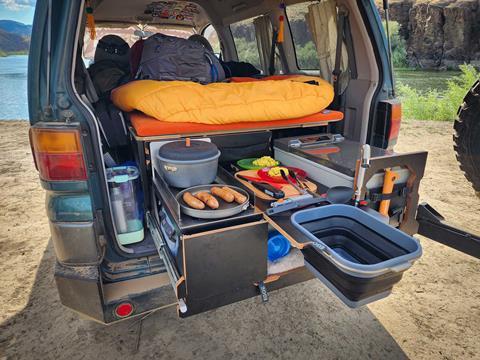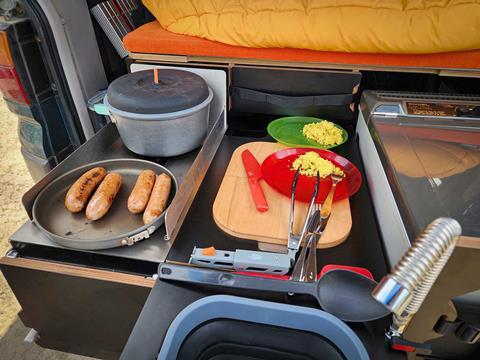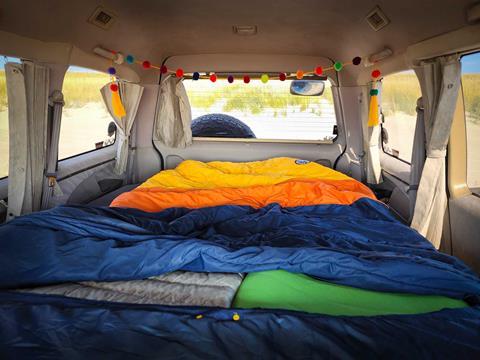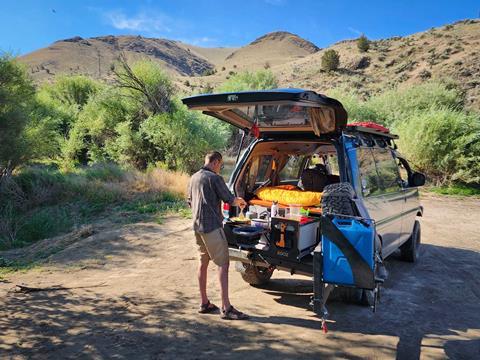Egoé is a company based in Czechia (the Czech Republic). For years it’s been manufacturing a host of things from outdoor furniture to bus shelters and they’re known for building high-quality transportation structures and modern furniture things from wood and metal that last.
The company also makes a host of products that can transform your vehicle into a camper without having to fully build it out and bolt-in any permanent setup. Behold, the Nestbox.

The Egoé Nestbox comes in a variety of sizes and shapes for a host of vehicles. Their most rugged, off-road-specific, overland-ready model is the Nestbox Supertramp. Designed around a welded steel frame with a black-powder coated finish, the Nestbox Supertramp features lots of precision crafted plywood parts with high-pressure laminate over the top.
It’s a modular, minimalist setup. There are sliding drawers with ballistic nylon drawer pulls you can fill with camping and cooking supplies.
The main slide-out can be equipped with a double-burner stove, a sink and four-gallon water container with faucet, and even a small Engel fridge/freezer. But wait, there’s more: The Nestbox Supertramp also includes a convertible sleeping platform and mattress. We have one in our 1994 Mitsubishi Delica and have been camping with it for a few months.

Egoé Specs
Without the cooking unit, sink unit, or fridge/freezer unit in place, the Egoé Nestbox Supertramp weighs a bit over 100 lbs. It’s secured in the vehicle using ballistic nylon straps with metal hooks. We have ours anchored to the floor where the rear seats used to be and to the seatbelt bolts; all applications will be slightly different depending on the vehicle. It should be noted that we removed the rear and middle seats of our van for the Nestbox, but many applications work with the vehicle’s seats installed.
With the drawers and optional fridge/freezer installed, the unit weighs 170 lbs. Overall, this is lightweight and certainly less weight than a full interior build-out. Plus, you can remove it when you want to use your van as a cargo- or people-mover.
The host of precisely routed plywood parts have exceptionally tight tolerances, something not necessarily expected from wood construction. But all the parts are smartly designed, have a modern style, and everything fits together with intended exactness.


Full-Featured and Innovative
The Egoé Nestbox has lots of tricks up its sleeves and is quite innovative. For example, the cook unit employs two removable backpacking stoves. Each burner uses its own fuel canister (just standard screw-on backpacking fuel). In fact, both burners can be separately removed, and you can take them hiking if you’d like.
Additionally, the entire cooking unit with both burners in place can be pulled from the Nestbox and put on a table. We found this feature useful during a windy evening in Washington State. The wind was gusting past the back of the van, but we were able to move the cook unit to a table on the van’s side where it wasn’t as breezy. FYI, you will need an ignitor or lighter to get the burners going, but they easily adjust with the turn of a knob and are powerful once lit.
Then there’s the sink unit. Lift the pressure-treated laminated shelf in the unit’s front and you’ll turn on the 12-volt water pump. Pop on your removable faucet, pull out the cutting board (with included super-sharp paring knife hidden underneath), and expand the collapsible sink: You now have running water with four gallons on tap. The water tank is removable, as is the entire kitchen module.

Finally, there’s the fridge/freezer unit. The tiny Engel MD17F 15-liter fridge works well, is quiet and efficient, but isn’t big. You can easily get a few days of food in it, or a six-pack, a steak, and veggies, but don’t expect to put lots in there. It’s a tight fit in the Nestbox, but it fits. An included Fiskars hatchet mounts in front of the fridge/freezer, and that can hamper the fridge’s ability to open easily; it takes some getting used to.
Also, the cord management on the Nestbox could be better. Theres a cord for the water pump and the fridge freezer, and they both tie into a 12-volt plug which either goes into your vehicle’s 12-volt socket, or can be hardwired, which is the setup I have. Though the cords are secured via Velcro to the Nestbox’s frame, I’ve found the cords can get in the way of closing the main drawer. You’ll have to find a solution that works best for your setup.


Space to Sleep
The Nestbox Supertramp also includes a fold-out sleeping platform and mattress. The platform is composed of two wood and metal beams that hook onto the Nestbox, two legs that attach at the ends, some wooden crossmembers, a few wood base pieces that go together like jigsaw pieces, wings that pull out to widen the platform, and a multi-panel folding foam mattress.
When not in use, the platform’s top sections and mattress sit atop the Nestbox and secure in place with two metal side tabs and an adjustable strap with clip. I wish the tabs were more rigid and kept things in place more securely when jostling around off-road.

There’s a learning curve to assembling the sleeping platform, and I suggest setting the bed up before your campsite happy hour as it can be tricky. Once you figure it out, it’s not hard, but there is a method to it.
The mattress is about 2-inches tall, 50-inches wide, and 73.6-inches long when atop the platform. The pad is on the firm side when sleeping. However, we’ve had many excellent nights of sleep on it, especially when we have our sleeping bag and a four-inch inflatable pad on the mattress. The space under the bed can be used for plenty of storage. Just be sure to leave room for the cards for the fridge/sink setup as they have to move around when the drawers are pulled out.

Overall Impressions
After using the Nestbox Supertramp for several months now, I can say that it’s overwhelmingly a positive experience. We’ve come to enjoy the easy access to a cooking space, having onboard running water, and the ability to have a fridge/freezer all out of the back of our van. The bed is secure, sturdy, and comfortable, too.
Since there is so much wood with the Nestbox, I wonder how it’ll hold up over time with various temperature swings. There’s also the issue of how the areas around the sink will stand up to water. Granted, it’s only seeing water when washing dishes and we wipe this area dry immediately after every use. But Egoé is known for its woodcraft, so if there’s any company that can reliably build a system like this with so much wood, it should be this company.
There are positives and negatives to modularity, however. For example, I had an incident this summer where I accidentally tipped over my coffee maker and coffee and grinds went everywhere in the Nestbox. Since it’s modular, we were able to pull it apart to clean it. On the flip side, because it’s modular, there are all kinds of nooks and crannies where the grounds went and required us to pull it all apart for cleaning. It’s the yin and yang of it all.
But overall, I can say the Nestbox Supertramp has been a great traveling companion and has transformed our Delica into a truly useful, versatile campervan.
Pricing
As of the time of this article’s writing, the Nestbox Supertramp starts at about $4,700, and that doesn’t include the optional Engel fridge. The fridge is approximately $1,000. For comparison’s sake, I was quoted $18,000 for a full buildout in our van and then we can’t use it to carry cargo anymore. So suddenly, $5,700+ doesn’t seem too bad. I certainly think the price is worth it, comparatively.
Access More Great Stories!
For more informative articles like this, consider subscribing to OVR Magazine in print or digital versions here. You can also find the print edition of OVR at your local newsstand by using our Magazine Finder.





















No comments yet